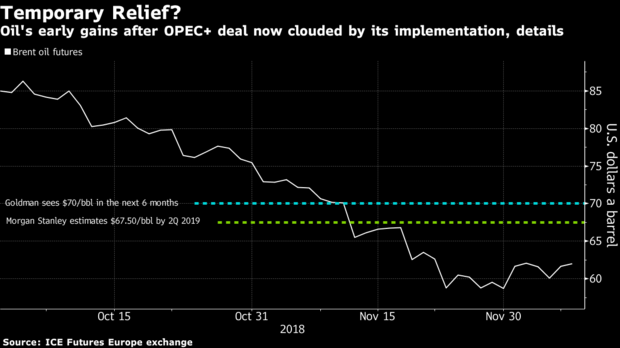Oil’s gains risk being quelled by uncertainty over how the OPEC+ coalition will implement its deal to cut output, according to Goldman Sachs Group Inc. and Morgan Stanley.
“The need for this physical evidence emanates from both the surprisingly large surplus of the global oil market in the second half of 2018 as well the absence of a clear picture on the implementation of the cuts,” Goldman analysts Damien Courvalin and Jeffrey Currie wrote in a Dec. 7 report.
Global benchmark Brent crude surged as much as 6 percent to trade above $63 a barrel in London on Friday on hopes that the higher-than-expected output curbs will drain the glut in supplies. Still, the rally quickly lost steam and halved its initial gain as the specter of slowing demand growth, fears of mounting pressure from Trump to lower prices and a potential increase in U.S. shale output haunted investors.

While prices can continue to rise as the pact between the Organization of Petroleum Exporting Countries and partners such as Russia significantly decreases the possibility of a glut, crude’s four-year high in early October is unlikely to be reached again in coming quarters, according to Morgan Stanley. Analyst Martijn Rats sees Brent reaching $67.50 a barrel by the second quarter of 2019, $10 lower than the bank’s previous estimate.
Non-OPEC Output
Output cuts by the producer group will in turn prompt non-OPEC countries to continue their production, implying a loss of market share for the cartel, Morgan Stanley said in a Dec. 8 report.
Meanwhile, Goldman said the market may rebalance in the first half of 2019 as Iranian production is squeezed by U.S. sanctions and a lack of new pipeline out of America’s Permian Basin slows production growth in the shale region. Moreover, both 2018 and 2019 global oil demand growth is understated, according to the bank.
The OPEC+ decision is “consistent with our forecast for a gradual return of the Brent forward curve into backwardation, and with stabilizing deferred prices, a gradual return of spot Brent prices to near $70 a barrel,” the Goldman analyst wrote in their report.
Looking ahead into the second half of 2019, however, Goldman is less optimistic “as OPEC+ attempts to sequentially grow and given an expected stabilization in Iran production, the unleashing of the Permian growth and back-end loaded growth in Canada, Brazil and Norway.”
With U.S. producers budgeting and realizing U.S. West Texas Intermediate crude at $55 a barrel in 2018 and beating production expectations, Goldman sees the risk of American output growth later next year should the OPEC+ cuts spur a significant price rally.

